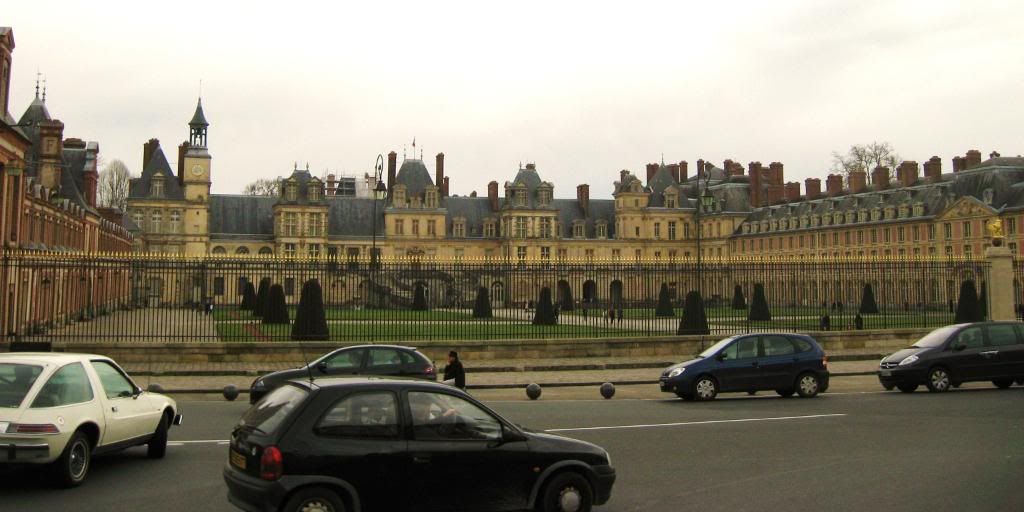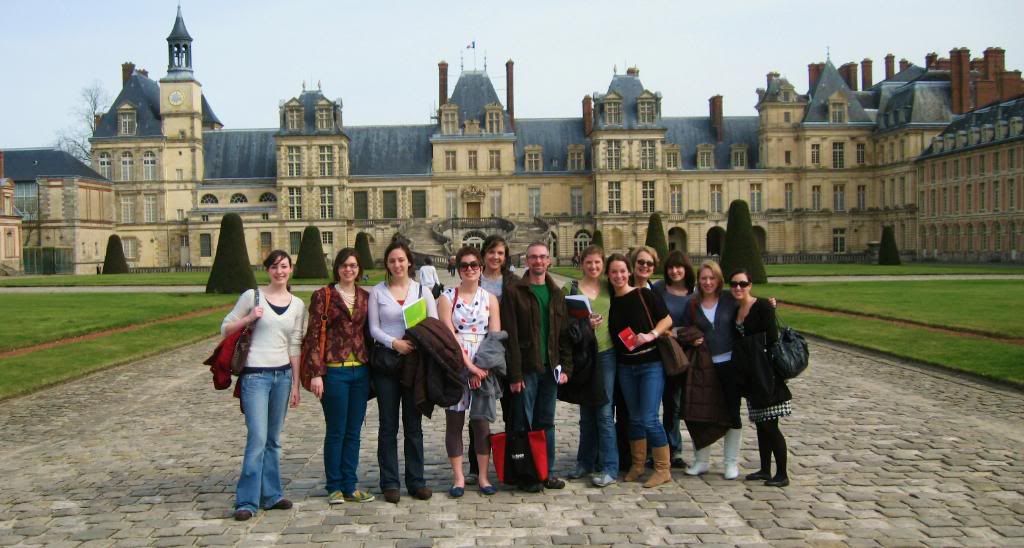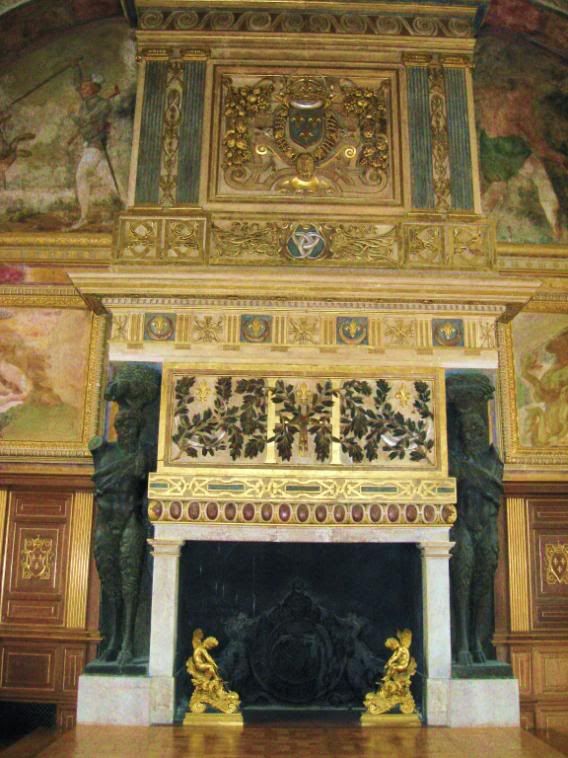
Today was a surprisingly warm and sunny day, perfect for our second group field trip. This time we went to Fontainebleau, the overlarge, overdecorated, and generally overwhelming former home to centuries of French royals. We met at Gare de Lyon, site of this lovely staircase (those of you who know me know that I have a mild obsession with staircases) and took a train out of Paris.

We're here! This is probably the widest shot you can get of Fontainebleau without a panoramic lens.

A nice man from Mexico City took this picture of us.
The 800-year-old Fontainebleau is, as Susan said today, "soaked in history." The earliest written mention of Fontainebleau dates back to 1137, when the château was used as a country hunting lodge. It wasn't until King Francois I (trivia: the first French king to speak French-- predecessors spoke Gallo-Roman languages) took it over in 1528 and began renovations that it became a true royal residence. Over the centuries the site has witnessed countless important historical events, from the 1598 signing of the Edict of Nantes to the 1814 attempted suicide and eventual abdication of Napoleon Bonaparte after his defeat at the Battle of Waterloo.


Exterior shots of the amazing Gone With the Wind-esque staircase at the main entrance.

Now begins the onslaught of shots from the interior. Fontainebleau's motto is "if you find surface area, decorate it." Italian masters were commissioned to do much of the early work on the palace, like these distinctive ceiling paintings.

When Pope Pius VII visited France for Napoleon's 1804 coronation as Emperor, he slept in this bed.

This chambre is called the Tapestry Room... see if you can guess why. Paul told us that tapestries were the most expensive items of interior decoration, far surpassing the cost of the paintings commissioned as their planning stages. Tapestries were more practical than paintings, though, in that they not only provided aesthetic appeal and the opportunity for allegorical storytelling, but were also useful for insulation and noise reduction in the cold, vast rooms of manor houses and castles.

I'm sad that having faces in your doors has gone out of style.
Every room in Fontainebleau is more opulent than the one before it. The next several pictures are all of the Galerie Francois I, who made the extended corridor his pet project during his time at Fontainebleau. He is even said to have kept the key to the gallery on his person at all times to ensure its safety. 



And these next ones are of the ballroom-- the balcony is where the musicians would've performed.
Next we have the Galerie Diane de Poitiers, a domed hallway-style library. Sadly the books are not original; much of Fontainebleau's original furnishings (and those of other historic palaces) were appropriated and sold during the French Revolution. The majority of the furniture at Fontainebleau today dates to Napoleon, who refurbished the château in the early 1800s.

Look, it's the library ladder that Belle used in Beauty and the Beast!

Next up is the bedroom of Empress Josephine, decorated in the Imperial Court style. As you may remember from Malmaison, Josephine's tastes were much more understated. A master of passive-aggressive diplomacy, she therefore left this room as-is but had another room outfitted for her use. All of the French queens from Marie de Medici (1600s) to Empress Eugenie (1800s) occupied this room. The cluster of upholstered stools in the foreground are for the queen's attendants, who would've assisted her in her bedtime and wakeup rituals.

Napoleon's throne room was originally the bedroom of Francois I-- doubtless the Emperor thought this would lend credibility to his reign.

Louis XV outfitted the Council Room in the 1700s, for the purposes of Men's Work (if you haven't been understanding this reference, I suggest a trip to Blockbuster for the claymation video of Rudolph the Red-Nosed Reindeer).

Napoleon's bedroom. After his 1809 divorce from Josephine, she was confined to Malmaison and Napoleon remained at Fontainebleau until his 1814 exile to Elba.

Our last stop was the altar of the in-palace chapel, consecrated by Thomas Beckett in the 12th century. This was the only picture that turned out moderately well, since the room was so dark.
And then we all went home and collapsed. The end!





3 comments:
That decor is ridiculous! So many tapestries! It's a little grandiose, but I do appreciate the frivolity.
-- Diane, who's tired and wants internet for more than five minutes at a time. aldkjgla;jgljaldgjaldj.
I agree with Diane, that place is ridiculous! And it's easy to see they really loved gold to border/accent/dominate...everything. Oh Sara, you and your staircases.
In these pictures I got some of ancient age.
Post a Comment